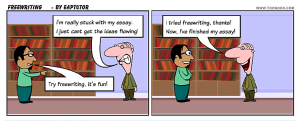The Writing Process

Introduction
It can be helpful for anybody who needs to write at university to think about the writing process. If you find writing essays difficult, or you have had disappointing grades, or even if you are doing well, but want to do even better, then thinking about the various stages in successfully completing a written assignment can help you achieve your goals. This is because, as you come to better understand your own writing process, you can see which areas can be improved. This Learning Object hopes to help you reflect on your own writing process and will suggest sources of help if problems are discovered along the way.
Objectives
- To encourage you to think about your writing process, with a view to improving it
- To suggest techniques you can use at the prewriting stage: to better access, record and organise your own ideas on a topic
- To help you benefit from peer and tutor feedback that you receive on your work
- To encourage more efficient proof-reading of work before submission
Activity 1: Thinking about your own writing process
To help you in analysing the process you usually use to write essays, it might be helpful for you to try to answer some questions. Irene Clark (2006) in her book “Writing The Successful Thesis And Dissertation: Entering The Conversation” asks the following questions:
“How much do you plan ahead before you begin to write? When you write, do you revise immediately, piece by piece before you write additional text? Do you save revision until all the text in a particular section has been written? Do you revise at all? What sort of revision do you do? What aspects of writing do you find most difficult? Generating ideas? Developing a main idea or position? Doing research? Beginning the paper? Organizing the paper? Providing transitions? Are you happy with your writing process? Do you find it effective? Is there some aspect of it you would like to change?”
Instruction
Read the instructions for each of the three tasks below, and write your answers in the boxes provided.
Firstly, think about your answers to the questions above, then we suggest you write your answers in the box below. You can write single word answers or phrases or sentences. You will be the audience (target reader), so you do not need to worry about mistakes with spelling or grammar.
Now, thinking about the prewriting and planning stages of writing an essay: what techniques do you currently use to generate and organise ideas? Is this a stage that you find easy or difficult? What do you understand by the terms: mindmapping, freewriting and clustering? Write your answers in the box below.
Thinking now about the feedback you receive on your first draft, how much do you revise your work in light of comments from other students and your tutor? It is a good idea to form a study group and read each other’s first drafts and make comments on what you read. What attitude should you have when doing this? Can you think of any things you should or shouldn’t do? What will you be looking for in the introduction? In the main body? In the conclusion? Overall? Write your answers in the box below.
Activity 2: Proof-reading your work
Although the most important aspect of your work is its content and structure, it is also important to pay attention to the surface features of your work. To gain a better understanding of the key surface features of an essay, study this visual representation of the different elements of an essay.
Clearly, it is desirable to try to ensure that the surface features of your essay are as accurate as possible in terms of: grammar, vocabulary selection, spelling and punctuation. In the activities that follow you will practise looking for mistakes and correcting them.
Instruction
Put a tick next to the sentences below that you think are correct. Alternatively, put a cross if you think there is a mistake in the sentence.


1.) In view of the above statement, it is pertinent to mention here that trade is basically necessity for every country.
2.) As we know that trade liberalisation refers to dismantling of tariff and non-tariff barriers.
3.) Through my point of view, the “American dream” is a hard-working person who earns much money, has a beautiful house, a happy, healthy family and gains respect from his friends.
4.) Studies have shown that a manager’s culture strongly influences his/her attitude and behaviour (Mason and Spich,1987).
5.) In thisessay, I will describe the Internet’s power, advantages and disadvantages in relation to the global marketplace.
6.) For example, through information obtained from the internet, companies can know about their competitors directly.
7.) Beyond the question what is eaten, driven in all over the world, ıt would also seem that we are moving toward a single worldview.
8.) It is our duty as individuals to ensure that food is not wasted and that donations are always made to those in need.
9.) The government should really get a closer look at this situation.
10.) Nowadays, there is a well developed financial system, well developed information and a well city planning over the world.
11.) Firstly, I will demonstrate the drastic situation of famine and hunger in the world and will provide the supporting evidence how people are suffering starvation.
12.) Firstly, there is another problem that causing in the world, which is climate change.
Write corrected versions of the sentences above that contained mistakes in the text entry box, then check your answers against the suggested corrections.
Would you like to review the main points?
© William Tweddle, Queen Mary, University of London, 2010, image generated online by the author using Wordle.com
 “
“